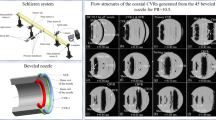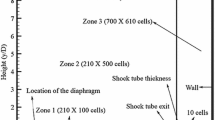Abstract
Head-on collision of the compressible vortex ring with a wall is studied experimentally for shock Mach number (M) varying from 1.31 to 1.85 using high-speed smoke flow visualizations. The compressible vortex ring is generated from the open end of a short driver section shock tube. At first, the interaction of the isolated compressible vortex ring with wall is characterized using diameter and translational velocity of the vortex ring and verified with flow visualizations. Different events such as vortex ring impingement on wall, wall vortex growth, and lift-off are identified from the change in slope of diameter and translational velocity. Next, the wall interaction of primary vortex ring embedded with counter rotating vortex ring (CRVR) is studied for M = 1.7 and 1.85. It has been observed that the presence of CRVR strongly influences the flow structure and formation of wall vortices. A case where CRVR first impinges on the wall showed a lesser lift-off due to formation of weak wall vortices. Strong scattered waves produced during wall interaction at high M (1.7 and 1.85) interact with trailing jet and create a secondary vortex ring at the trailing jet. Pressure measurements along the wall surface have also showed the impingement, wall vortex growth, lift-off besides shocklet formation.
Graphical Abstract
Graphical Abstract text












Similar content being viewed by others
Abbreviations
- M :
-
Incident shock Mach number
- x :
-
Plate distance from shock tube exit
- t :
-
Time (incident shock at the shock tube exit is denoted by t = 0)
- L :
-
Driver section length
- D :
-
Shock tube inner diameter
- D r :
-
Vortex ring diameter
- D rw :
-
Vortex ring diameter before impingement
- U r :
-
Vortex ring’s translational velocity in the axial direction
- U rw :
-
Vortex ring’s translational velocity before impingement
- V r :
-
Vortex ring’s lateral velocity
- CRVR:
-
Counter rotating vortex ring
- t w :
-
Time at which vortex ring impinges on the wall
- U b :
-
Velocity behind the incident shock
- t* = t × U b/D :
-
Non-dimensional time
References
Arakeri JH, Das D, Krothapalli A, Lourenco L (2004) Vortex ring formation at the open end of a shock tube: a PIV study. Phys Fluids 30:1008–1019
Brouillette M, Hebert C (1997) Propagation and interaction of shock generated vortices. Fluid Dyn Res 21:159–169
Duport P, Croisier G, Werquin O, Stanislas M (2002) DPIV, HPIV and visualization study of a vortex ring–moving wall interaction. Exp Fluids 33:555–564
Kontis K, An R, Edwards JA (2006) Compressible vortex ring studies with a number of generic body configurations. AIAA J 44:2962–2978
Kontis K, An R, Zare-Behtash H, Kounadis D (2008) Head-on collision of shock wave induced vortices with solid and perforated walls. Phys Fluids 20:016104
Lim TT (1989) An experimental study of a vortex ring interacting with an inclined wall. Exp Fluids 7:453–463
Lim TT, Nickels TB, Chong MS (1991) A note on the cause of rebound in the head on collision of vortex ring with a wall. Exp Fluids 12:41–48
Minota T, Nishida M, Lee MG (1997) Shock formation by compressible vortex ring impinging on a wall. Fluid Dyn Res 21:139–157
Murugan T (2008) Flow and acoustic characteristics of high Mach number vortex rings during evolution and wall-interaction: an experimental investigation. PhD thesis, Indian Institute of Technology, Kanpur, India
Murugan T, Das D (2010) Characteristics of counter-rotating vortex rings formed ahead of a compressible vortex ring. Exp Fluids 49:1247–1261
Murugan T, De S (2011) Numerical visualization of counter rotating vortex ring formation ahead of shock tube generated vortex ring. J Vis. doi:10.1007/s12650-011-0110-1
Murugan T, Das D, Jain M (2008) On the collision of compressible vortex ring with wall. J Vis 11:277
Murugan T, De S, Dora CL, Das D (2011a) Numerical simulation and PIV study of formation and evolution of compressible vortex ring. Shock Waves. doi:10.1007/s00193-011-0344-9
Naguib AM, Koochesfahani MM (2004) On wall-pressure sources associated with the unsteady separation in a vortex–ring wall interaction. Phys Fluids 16:2613–2622
Naitoh T, Banno O, Yamada H (2001) Longitudinal vortex structure in the flow field produced by a vortex ring impinging on a flat plate. Fluid Dyn Res 28:61–74
Szumowski A, Sobieraj G, Selerowicz W, Piechna J (2000) Starting jet–wall interaction. J Sound Vib 232:695–702
Walker JD, Smith DA, Doligalski TL, Cerra AW (1987) Impact of a vortex ring on a wall. J Fluid Mech 181:99–140
Acknowledgments
The authors acknowledge partial financial support received from Indian Space Research Organization (ISRO), India, for this work.
Author information
Authors and Affiliations
Corresponding author
Rights and permissions
About this article
Cite this article
Thangadurai, M., Das, D. Experimental study on a compressible vortex ring in collision with a wall. J Vis 15, 321–332 (2012). https://doi.org/10.1007/s12650-012-0138-x
Received:
Accepted:
Published:
Issue Date:
DOI: https://doi.org/10.1007/s12650-012-0138-x




